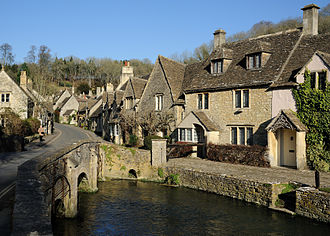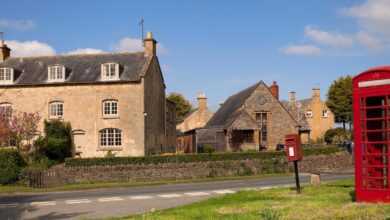Discover the Cotswolds

Discover the Cotswolds: England’s Timeless Countryside Charm
Introduction
Nestled in the heart of England, the Cotswolds is one of the country’s most beautiful and beloved regions, known for its rolling hills, honey-colored stone villages, and timeless English countryside charm. Spanning across six counties—including Gloucestershire, Oxfordshire, and Worcestershire—the Cotswolds attract millions of visitors each year who come to experience its peaceful landscapes, historic towns, and authentic rural life.
The Essence of the Cotswolds
The Cotswolds is officially designated as an Area of Outstanding Natural Beauty (AONB), covering nearly 800 square miles. What makes it truly special is its blend of unspoiled nature and traditional English heritage. Every village tells a story—through ancient churches, cozy pubs, and centuries-old cottages made from golden Cotswold stone.
The region’s landscape is a painter’s dream: gentle hills (known locally as “wolds”), meandering rivers, and wildflower meadows that seem to come straight out of a postcard.
Must-Visit Villages in the Cotswolds
1. Bourton-on-the-Water
Often called the Venice of the Cotswolds, this charming village features stone bridges arching over the River Windrush. Its boutique shops, traditional tea rooms, and riverside walks make it a perfect starting point.
2. Bibury
Described by artist William Morris as “the most beautiful village in England,” Bibury’s Arlington Row cottages are among the most photographed spots in the country.
3. Stow-on-the-Wold
A historic market town filled with antique shops, independent cafés, and a beautiful medieval church. Don’t miss the iconic tree-framed doorway of St. Edward’s Church.
4. Broadway
Known as the “Jewel of the Cotswolds,” Broadway is famous for its elegant Georgian architecture and the stunning Broadway Tower, offering panoramic countryside views.
Things to Do in the Cotswolds
- Walking & Hiking: The Cotswold Way National Trail stretches over 100 miles, offering incredible walking routes through scenic hills and hidden villages.
- Explore History: Visit Sudeley Castle, Blenheim Palace, or the Roman heritage sites in Cirencester.
- Local Cuisine: Enjoy classic English dishes made with local produce—Cotswold cheese, farmhouse cider, and fresh honey are must-tries.
- Shopping & Crafts: The Cotswolds are home to local artisans, potters, and farmers’ markets where you can find handmade crafts and local goods.
Best Time to Visit the Cotswolds
Each season adds its own magic.
- Spring brings blooming daffodils and lambs in the fields.
- Summer is perfect for outdoor picnics and long walks.
- Autumn paints the Cotswolds in warm gold and amber tones.
- Winter turns villages into storybook scenes with cozy pubs and festive markets.
How to Reach the Cotswolds
The Cotswolds is easily accessible from London, Bristol, or Birmingham. You can travel by train to towns like Moreton-in-Marsh or drive along the scenic A40 and A44 routes. Once there, renting a car or bicycle gives you the freedom to explore every hidden gem at your own pace.
Conclusion
The Cotswolds perfectly capture the soul of rural England—peaceful, picturesque, and rich in history. Whether you’re seeking a quiet weekend getaway, a photography escape, or a deep dive into English culture, the Cotswolds promise an unforgettable experience that feels like stepping into another time.
Frequently Asked Questions (FAQs) About the Cotswolds
1. Where exactly are the Cotswolds located?
The Cotswolds are located in south-central England, stretching across parts of Gloucestershire, Oxfordshire, Warwickshire, Wiltshire, Worcestershire, and Somerset. The area lies between major cities like London, Bristol, and Birmingham, making it easy to reach by car or train.
2. What makes the Cotswolds famous?
The Cotswolds are famous for their rolling green hills, honey-colored stone cottages, and traditional English villages that seem frozen in time. It’s also known for scenic walking trails, charming market towns, and cozy pubs that reflect authentic British countryside life.
3. What are the best villages to visit in the Cotswolds?
Some of the must-see villages include Bibury, Bourton-on-the-Water, Stow-on-the-Wold, Burford, and Broadway. Each has its own unique charm—riverside walks, antique markets, medieval churches, and postcard-perfect architecture.
4. How can I travel around the Cotswolds?
The best way to explore the Cotswolds is by car, giving you the freedom to visit smaller villages and countryside lanes. However, public transport is available—buses and trains connect major towns like Moreton-in-Marsh, Cheltenham, and Cirencester.
5. When is the best time to visit the Cotswolds?
The Cotswolds are beautiful year-round. Spring and summer offer lush greenery and outdoor activities, while autumn brings colorful foliage. Winter is cozy and peaceful, perfect for enjoying log fires and festive markets.
6. What outdoor activities can I do in the Cotswolds?
Visitors can enjoy hiking the Cotswold Way Trail, cycling through scenic routes, horseback riding, or simply exploring gardens, lakes, and wildlife parks. The region is also great for photography, picnics, and countryside picnics.
7. Are the Cotswolds suitable for families?
Yes, the Cotswolds are family-friendly with many attractions for all ages—animal parks, open farms, playgrounds, and gentle walking routes. Families also love exploring local tearooms, ice-cream shops, and traditional fairs.
8. Can I visit the Cotswolds on a day trip from London?
Absolutely! Many travelers take a day trip from London to the Cotswolds, especially to towns like Bibury, Burford, or Bourton-on-the-Water. It’s roughly a 2-hour drive or train ride, making it a perfect countryside escape from the city.
9. Where can I stay in the Cotswolds?
Accommodation options in the Cotswolds range from luxury country hotels and spa resorts to traditional inns, cottages, and B&Bs. Many visitors choose cozy village stays to experience the authentic charm of rural England.
10. What food is the Cotswolds known for?
The region is famous for Cotswold cheese, fresh farm produce, homemade pies, local cider, and afternoon teas. Don’t miss the Sunday roast at a local pub—it’s a true taste of English comfort food!



